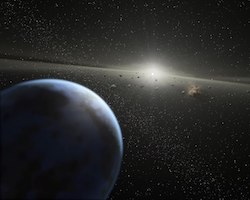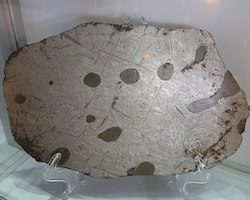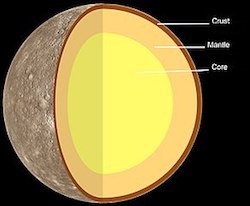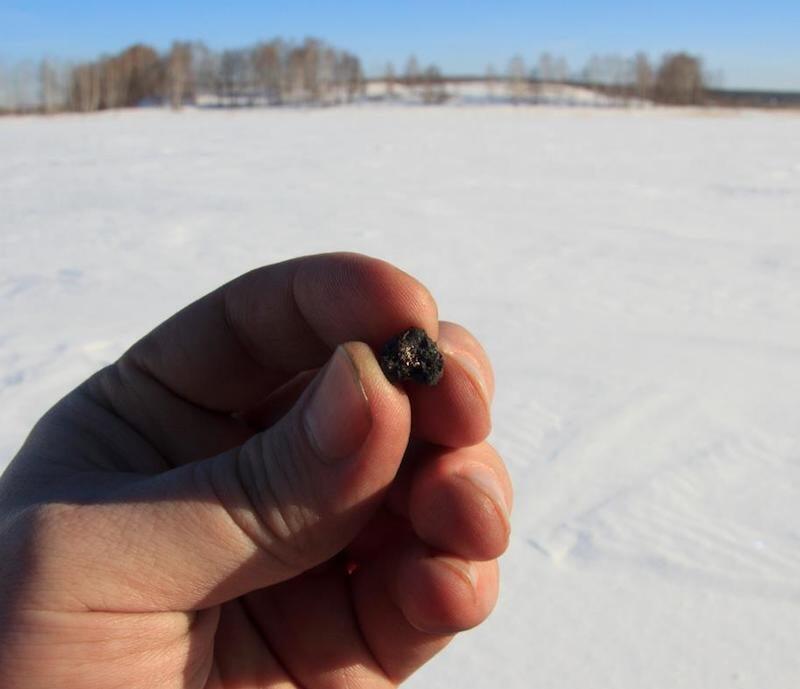
Meteorites: Space Rocks!
 You lie back on the ground and zip up your sleeping bag to stay warm. Out here, under the dark and clear desert skies with very little cloud cover, every bit of space looks like it is studded with stars. A streak of light passes right through the middle of the sky—a falling star. But what you’ve just seen isn’t really a star falling from the sky. It’s a meteor: a rock from space that is traveling through Earth’s atmosphere. When it hits the ground, it is not a meteor anymore. Then it is called a meteorite.
You lie back on the ground and zip up your sleeping bag to stay warm. Out here, under the dark and clear desert skies with very little cloud cover, every bit of space looks like it is studded with stars. A streak of light passes right through the middle of the sky—a falling star. But what you’ve just seen isn’t really a star falling from the sky. It’s a meteor: a rock from space that is traveling through Earth’s atmosphere. When it hits the ground, it is not a meteor anymore. Then it is called a meteorite.
Where do meteorites come from?
Most meteorites come from asteroids in the asteroid belt between Mars and Jupiter. Asteroids are rocky or metal bodies (objects) that revolve around the Sun. Asteroids are mostly leftovers from the processes that happen when planets are formed. They can range in size from that of a boulder to hundreds of miles across.
 Objects smaller than asteroids are called meteoroids, and they are usually much smaller – about the size of pebbles. Some meteorites may also come from Mars or the Moon. When the orbit or path of an asteroid or meteoroid crosses Earth, it starts its journey through the Earth’s atmosphere (meteor) until it lands on the surface (meteorite). Then scientists can try to trace back where the meteorite came from.
Objects smaller than asteroids are called meteoroids, and they are usually much smaller – about the size of pebbles. Some meteorites may also come from Mars or the Moon. When the orbit or path of an asteroid or meteoroid crosses Earth, it starts its journey through the Earth’s atmosphere (meteor) until it lands on the surface (meteorite). Then scientists can try to trace back where the meteorite came from.
What are meteorites made of?
Are all meteorites the same? No! They can come from different planets, asteroids, or meteoroids, or even different parts of the same object. Because of this, they can look different and can be made of different materials.
 All meteorites can be put into one of three main categories, depending on the materials from which they are made. Iron meteorites are made mostly of iron and nickel. Stony-iron meteorites are made of iron and rock silicates. Stony meteorites are made mostly of rock silicates. The materials from which a meteorite is made greatly affect how heavy a meteorite is.
All meteorites can be put into one of three main categories, depending on the materials from which they are made. Iron meteorites are made mostly of iron and nickel. Stony-iron meteorites are made of iron and rock silicates. Stony meteorites are made mostly of rock silicates. The materials from which a meteorite is made greatly affect how heavy a meteorite is.
How heavy or dense a material is can be important for where it ends up. We can see how important this is if we travel back to what happened when our solar system and planets first formed.
Why are meteorites made of different materials?
Our solar system started out as hot gas. When gas clouds condensed, the Sun was formed and solids combined to form planets. The leftover solids that did not fall into the Sun or form planets became asteroids. Some of these asteroids had enough heat due to radioactive decay to melt. The metal (mostly iron and nickel), being heavier, sank to the center of the molten mass and formed the metallic core of the body. The lighter rocky material floated on top and formed the mantle and crust. It is similar to how oil (lighter) floats on water (heavier).
 All terrestrial or inner planets (Mercury, Venus, Earth, and Mars) and some asteroids have such a layered, or differentiated structure. You can think of it as the layered structure of an onion. Some of these asteroids with different layers were hit by other asteroids and broken apart. That is how we have meteorites from different layers of a body. Such meteorites are called achondrites. So, an achondrite can be an iron meteorite if it comes from the core of the body or a stony meteorite if it comes from the crust or mantle of the body. Or it could be a stony-iron meteorite if it comes from the boundary between the core and the mantle.
All terrestrial or inner planets (Mercury, Venus, Earth, and Mars) and some asteroids have such a layered, or differentiated structure. You can think of it as the layered structure of an onion. Some of these asteroids with different layers were hit by other asteroids and broken apart. That is how we have meteorites from different layers of a body. Such meteorites are called achondrites. So, an achondrite can be an iron meteorite if it comes from the core of the body or a stony meteorite if it comes from the crust or mantle of the body. Or it could be a stony-iron meteorite if it comes from the boundary between the core and the mantle.
But not all asteroids melt. Some asteroids do not have enough radioactive heat to melt them. In such asteroids, the minerals (metal, silicates, etc.) are all mixed together. Meteorites from such asteroids are called chondrites and they are stony meteorites.
Additional images via Wikimedia Commons. Chebarkul lake meteorite image by Denis Panteleev.
Bibliographic Details
- Article: Meteorites: Space Rocks!
- Author(s): Soumya Ray, Zachary Torrano
- Publisher: Arizona State University Learning Enterprise Ask An Earth & Space Scientist
- Site name: ASU - Ask An Earth And Space Scientist
- Date published:
- Date modified:
- Date accessed: January 4, 2026
- Link: https://askanearthspacescientist.asu.edu/explore/meteorites
APA Style
Soumya Ray, Zachary Torrano. (). Meteorites: Space Rocks!. Retrieved {{ nothing_3 }}, from {{ view_node }}
American Psychological Association, 6th ed., 2nd printing, 2009.
For more info, see the
APA citation guide.
Chicago Manual of Style
Soumya Ray, Zachary Torrano. "Meteorites: Space Rocks!." ASU - Ask An Earth And Space Scientist. Published . Last modified . https://askanearthspacescientist.asu.edu/explore/meteorites.
Chicago Manual of Style, 17th ed., 2017.
For more info, see the
Chicago Manual citation guide.
MLA Style
Soumya Ray, Zachary Torrano. Meteorites: Space Rocks!. ASU - Ask An Earth And Space Scientist. , {{ view_node }}. Accessed 2026, Jan 4.
Modern Language Association, 8th ed., 2016.
For more info, see the
MLA citation guide.

Meteorites vary widely in size, from small pebbles to large boulders. This small meteorite was found in 2013 at Chebarkul lake, in Russia.
Be Part of
Ask An Earth and
Space Scientist
By volunteering, or simply sending us feedback on the site. Scientists, teachers, writers, illustrators, and translators are all important to the program. If you are interested in helping with the website we have a volunteers page to get the process started.
